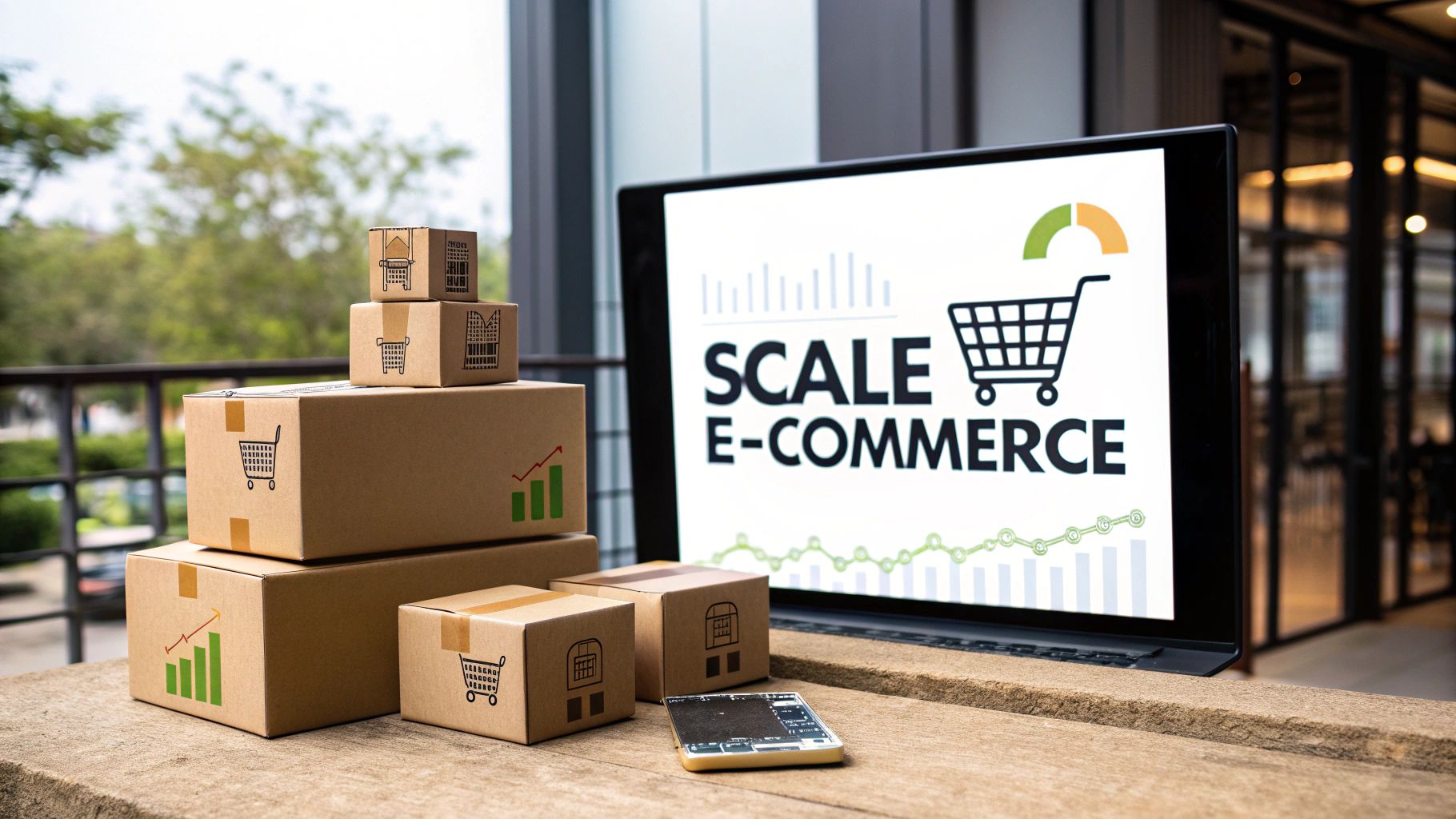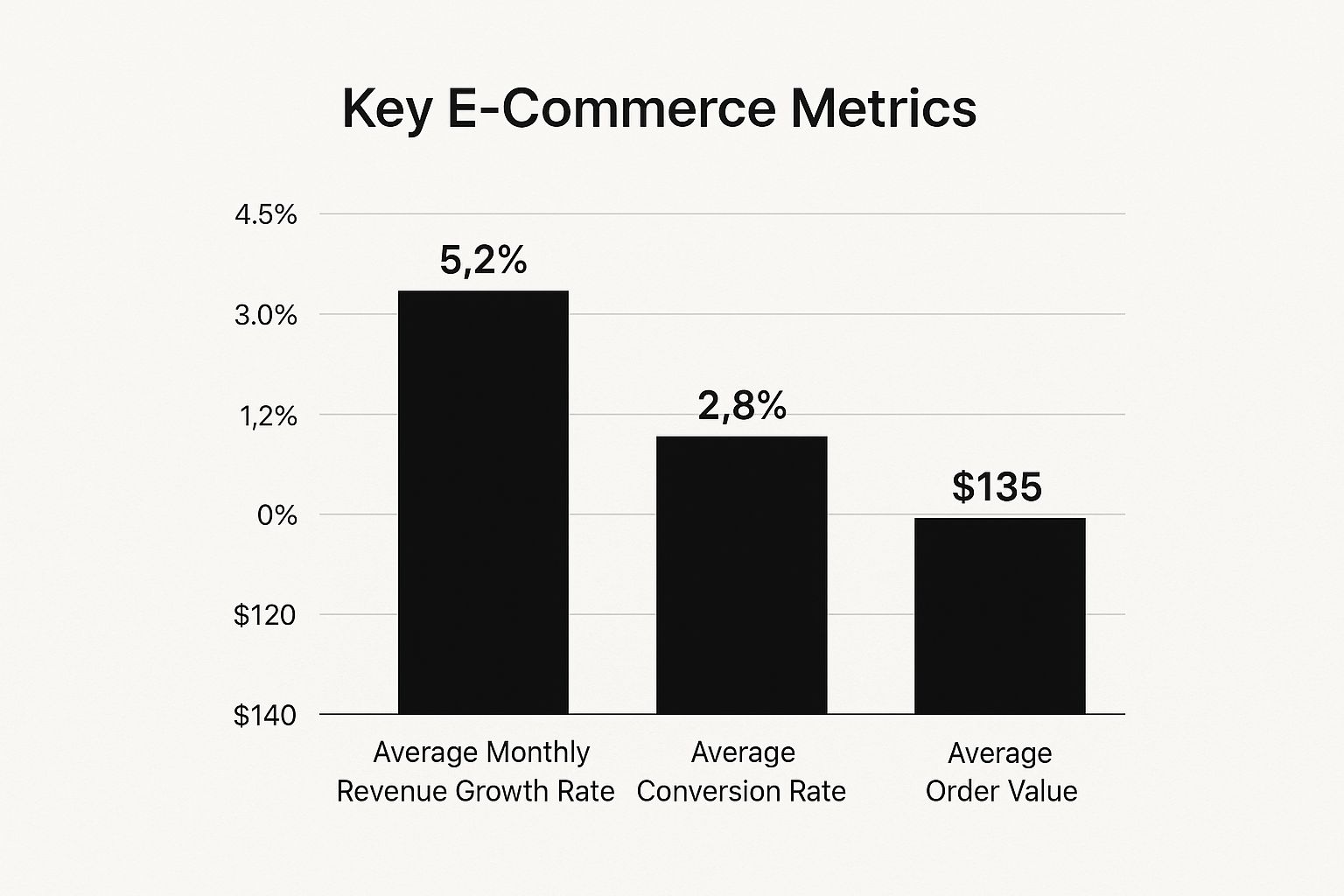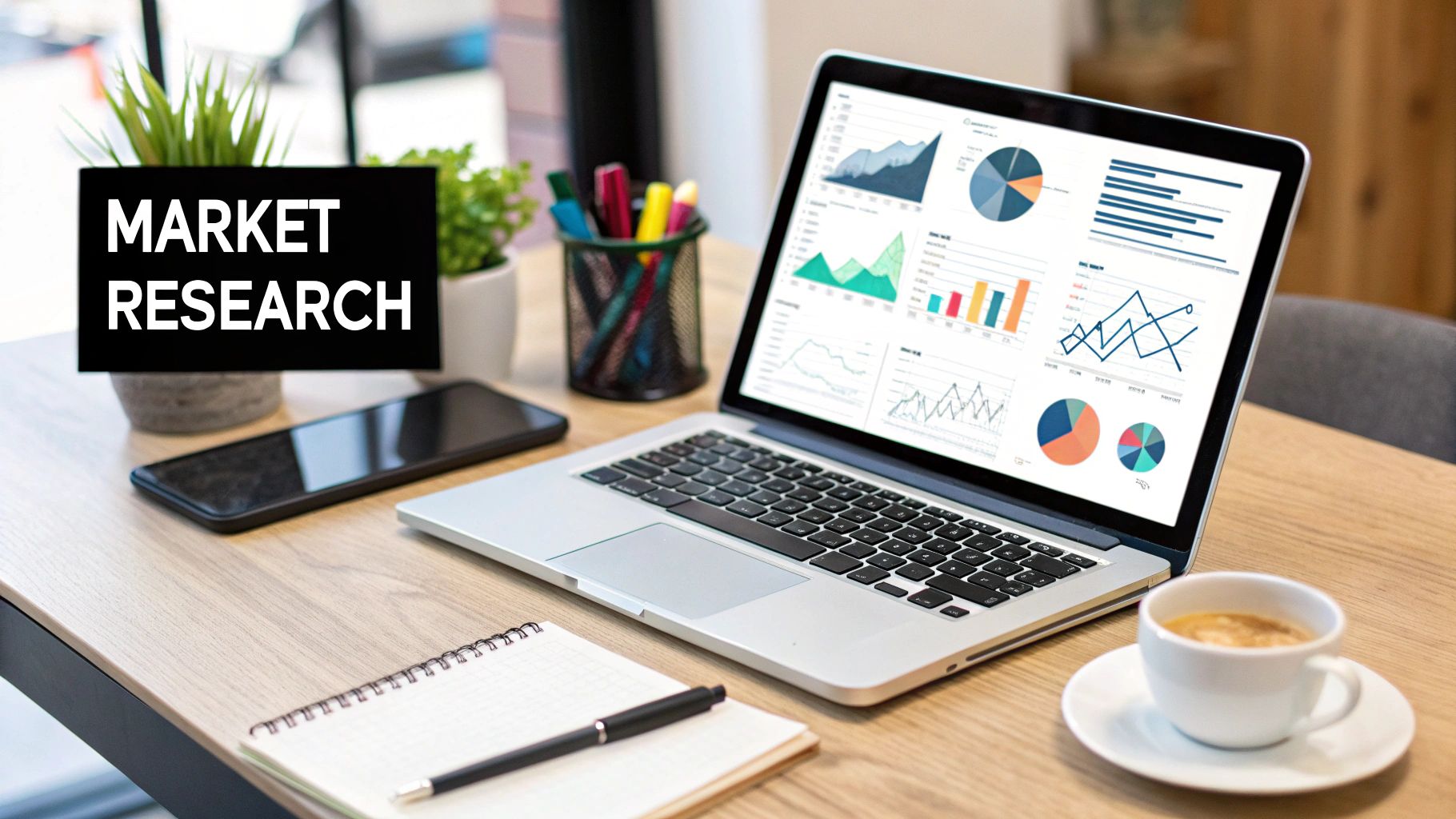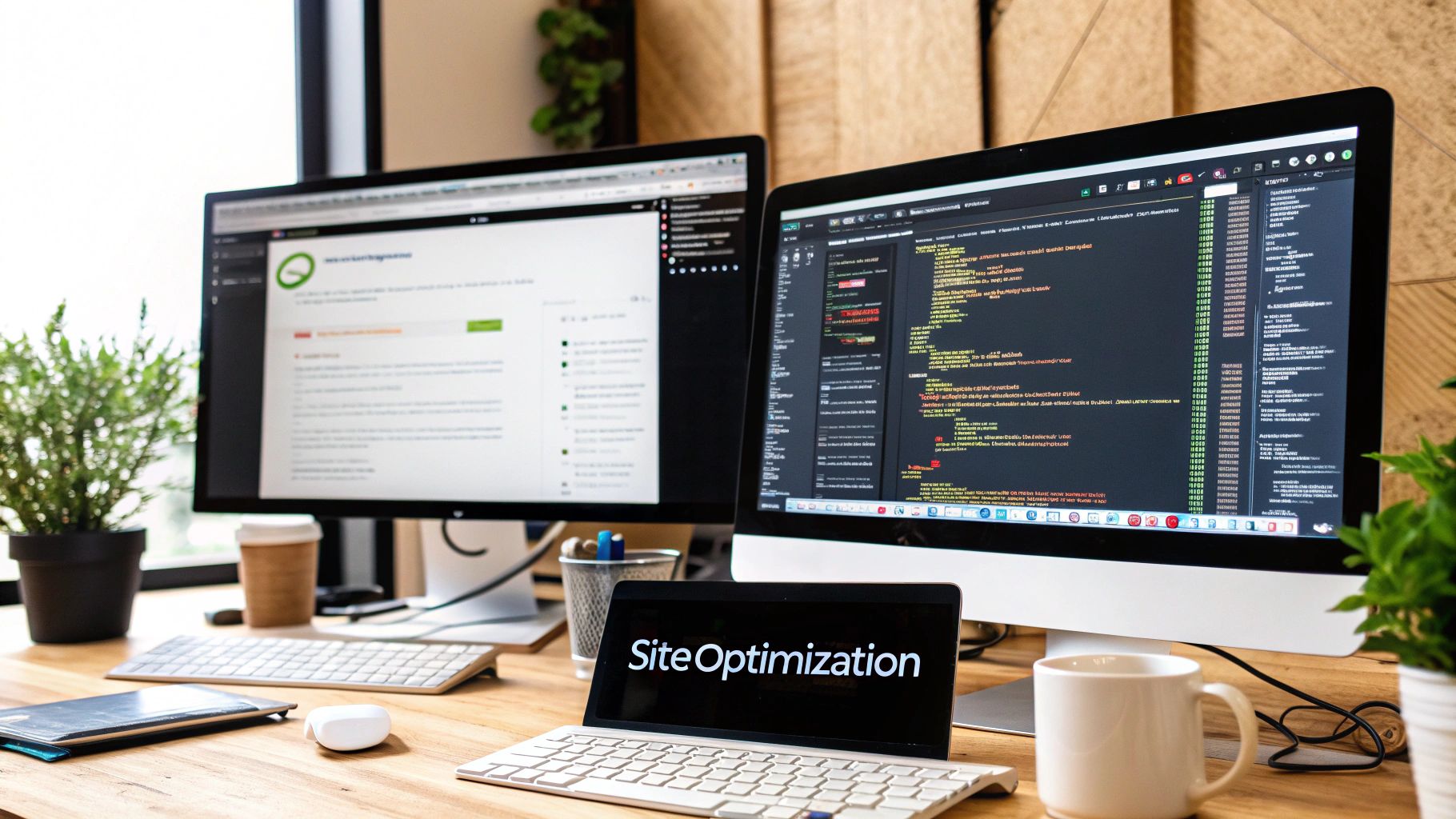Stay Updated with Everything about MDS
Thank you! Your submission has been received!
Oops! Something went wrong while submitting the form.

Chilat Doina
October 5, 2025
Tired of chasing fleeting trends? If you want to really grow your e-commerce business, you need to stop thinking in terms of one-off tactics and start building a sustainable framework. It all boils down to mastering five core areas: smart marketing, seamless fulfillment, data-driven decisions, product optimization, and customer retention. Get these right, and you're not just growing—you're building an interconnected system for long-term success.
Scaling an e-commerce brand is less about jumping on every shiny new object and more about methodical execution on the things that actually move the needle. A scattered approach just burns through cash and leaves you stuck.
Think of your business like a high-performance engine. Every component has to work in perfect harmony. Brilliant marketing gets customers in the door, but it’s the seamless fulfillment that makes them happy they walked through it.
This balanced approach saves you from the classic scaling headaches, like that viral marketing campaign that completely torpedoes your unprepared shipping department. When you look at growth through a structured lens, every decision becomes more deliberate and impactful. To really flesh this out, check out this guide on a comprehensive ecommerce growth strategy—it's loaded with great ideas.
Your entire scaling journey should be built on these five non-negotiable pillars. Each one hits a critical part of your customer's experience and your own internal operations.
With the global e-commerce market expected to hit a staggering $8.3 trillion in 2025, the stakes are high. And with over 70% of online purchases now happening on mobile, you can't afford to have a disconnected strategy.
Not all growth efforts are created equal. Some require a ton of resources for a massive payoff, while others offer quick wins. Here's a quick breakdown to help you prioritize where to focus your time and money.
As you can see, a focus on analytics can yield a high return for a relatively low investment, while marketing often requires significant capital but delivers huge results. The key is finding the right balance for your current stage of growth.
You can't improve what you don't measure. Getting a handle on your Key Performance Indicators (KPIs) is non-negotiable. This chart breaks down some of the most critical metrics that successful e-commerce brands live and die by.

The data really shows how attracting customers (growth rate), getting them to buy (conversion rate), and increasing what they spend (AOV) are all tangled together. A solid plan has to tackle all three.
Following strategic planning best practices is essential here. It helps you set goals that are actually achievable and put your resources behind the pillars that will have the biggest impact. This isn't just a list of things to do; it's a framework for building a brand that lasts.

Your marketing is what pulls new customers into your orbit. But let's be honest, just throwing money at ads is a surefire way to burn cash without seeing any real growth. Smart marketing isn't about volume; it's about precision—reaching the right people, with the right message, at exactly the right time.
This means you have to move beyond generic, one-size-fits-all campaigns. It’s about digging into what actually makes your ideal customer tick. A winning strategy isn’t just about a single channel, either. It’s a connected system where search, social, and email all play together to create a smooth and compelling journey for the shopper.
The potential here is massive. E-commerce is on track to make up nearly 24% of all global retail sales by 2025. To grab your slice of that pie, a targeted, efficient marketing plan isn't just nice to have—it's essential.
Before you even think about spending a dollar on ads, your online store has to be ready to convert the traffic that finds you on its own. That's where Search Engine Optimization (SEO) comes in. It's the bedrock of your marketing, making sure customers can actually find you when they're searching for products just like yours.
Think of SEO as putting up the best possible signposts to guide both search engines and users straight to your product pages. This goes way beyond just stuffing keywords into your descriptions.
Once your SEO foundation is solid, paid advertising can seriously amplify your reach. But spending money on ads effectively requires a data-driven approach, not a "set it and forget it" mentality.
Imagine a niche apparel brand selling vintage-inspired graphic tees. Instead of a broad campaign targeting anyone interested in "t-shirts," they could create hyper-specific ads targeting users who follow certain retro fashion influencers, love 80s movies, and live in particular cities. That’s the kind of focus that drives sales.
Key Takeaway: The real power of paid ads is in laser-focused targeting and constant testing. Never assume you know what will work. Test your ad copy, your images, and your audience segments to find the most profitable combinations.
This cycle of refining and improving, often called A/B testing, is where you find the big wins. Just be sure to test one thing at a time—the headline, the image, the call-to-action—so you know exactly what’s moving the needle.
Today's shoppers trust other shoppers far more than they trust brands. That’s precisely why user-generated content (UGC) and influencer marketing have become such potent growth tools.
Get your customers involved! Encourage them to share photos of themselves with your products by creating a unique hashtag or running a contest. Featuring these authentic images on your product pages can boost conversion rates by building instant trust and credibility.
Influencer collaborations tap into the same principle. Partnering with a micro-influencer whose audience is a perfect match for your brand can be way more effective (and affordable) than shelling out for a huge celebrity. Their endorsement feels like a genuine recommendation from a trusted friend, not a slick advertisement. For a deeper dive, check out our guide on powerful e-commerce marketing strategies.
Let’s face it: not every visitor will buy on their first visit. Email marketing is your most valuable tool for staying in touch with these potential customers and turning existing ones into repeat buyers.
The first step is building your email list. Offer something compelling, like a 10% discount on their first purchase, to get them to sign up. Once they're on your list, you can set up automated email sequences that work for you around the clock.
Essential Email Automations:
By combining an optimized storefront with targeted paid ads, authentic social proof, and a smart email strategy, you build a robust marketing machine that consistently attracts and converts new customers, paving the way for sustainable e-commerce growth.

Let's be honest: fast, reliable shipping isn't a "nice-to-have" anymore. It's table stakes. Your customers expect it, and a clunky fulfillment process is a silent killer, slowly bleeding your profit margins and torching the customer loyalty you’ve busted your butt to build.
Nailing your fulfillment is one of the biggest leaps you can make when learning how to grow your e-commerce business. The fundamental choice you have to make is whether to handle it all yourself or to bring in a specialized partner. Each path has serious trade-offs that will ripple through your costs, your control, and your ability to grow.
This is one of the most critical operational decisions you’ll make. Going the in-house route gives you total control over the entire show—from how you manage inventory to that final unboxing experience. You can toss in personal touches, like handwritten thank-you notes, that a massive fulfillment center just can't replicate.
But that level of control doesn't come free. You're on the hook for everything: leasing warehouse space, hiring and managing a team, wrestling with shipping carriers for decent rates, and buying all your packing supplies. As orders ramp up, these fixed costs and headaches can become a massive anchor.
On the other side of the coin, a third-party logistics (3PL) provider takes all of that off your plate. They are specialists in storing, picking, packing, and shipping. Because they operate at such a huge scale, they often get much better shipping rates than you ever could on your own. This frees you up to do what you do best: marketing your brand and developing awesome products.
I saw this firsthand with a mid-size apparel brand that was drowning trying to keep its two-day delivery promise. They partnered with a 3PL with warehouses on both coasts. By splitting their inventory, they slashed their average shipping time by over 30% and cut shipping costs by 18%. It completely changed their customer experience, almost overnight.
Making the right choice between in-house and outsourced fulfillment depends entirely on your business's current stage, order volume, and long-term goals. Here's a quick breakdown to help you weigh the options.
Ultimately, the best model is the one that removes operational friction and supports your growth trajectory without breaking the bank.
If you decide outsourcing is the move, don't just pick the first 3PL you find on Google. A bad partner can be way more damaging than a poorly run in-house operation. To get a head start, you can check out our detailed comparison of the https://milliondollarsellers.com/blog/best-ecommerce-fulfillment-companies.
When you're vetting potential 3PLs, focus on these key areas:
There's a reason this industry is exploding. The global e-commerce fulfillment market is on track to hit $140 billion in 2025, growing at 13.2% a year. With around 60% of online sellers now outsourcing at least some of their fulfillment, it's a battle-tested model for growth.
Whether you fulfill in-house or with a partner, you can’t escape the need for smart inventory management. This is the backbone of a scalable operation. Implementing effective inventory management strategies is non-negotiable for keeping stock levels lean and costs down.
This means digging into your data to forecast demand, setting smart reorder points so you don't run out of your bestsellers, and truly understanding your carrying costs. An optimized supply chain is all about having the right product in the right place at the right time. When you get this piece of the puzzle right, you build the foundation for a world-class delivery experience and truly sustainable growth.
Gut feelings are great for getting a business off the ground. But they're a terrible way to scale one.
The e-commerce brands that stick around for the long haul are the ones built on a solid foundation of data. It’s all about swapping guesswork for genuine insight.
To really understand how to grow, you have to move past surface-level numbers like website traffic. The real magic happens when you start focusing on the metrics that directly impact your bottom line and sustainability. This shift is what separates the brands that thrive from those that just tread water.
The point isn't to get lost in an endless sea of spreadsheets. It's about zeroing in on a handful of key performance indicators (KPIs) that give you a clear, actionable snapshot of your business's health at any given moment.
Too many founders get caught up chasing vanity metrics. Clicks and impressions feel good, but they don't pay the bills. If you want to make smarter decisions, you need to live and breathe the numbers that reflect the true health of your customer relationships and your bank account.
Here are the big three you absolutely have to track:
When you start looking at how these metrics play together, you unlock some seriously powerful insights. For example, if your CLV is three times your CAC, you've got a very healthy and profitable model. If they're too close for comfort, you're probably burning too much cash to acquire customers who don't stick around.
Data is only useful if it helps you answer important questions. One of the best tools for this is cohort analysis, which is a fancy way of saying you group customers based on when they first bought from you and then watch how they behave over time.
This approach helps you see beyond broad averages. Are customers you acquired during a big holiday sale less loyal? Do people who buy a specific product first tend to spend more over their lifetime?
Real-World Scenario: An online electronics store noticed its repeat purchase rate had gone flat. Using cohort analysis, they grouped customers by their first purchase. They found that customers whose first purchase was a pair of high-end headphones were 25% more likely to make a second purchase within 90 days than those who first bought a cheaper accessory.
Armed with this insight, they completely flipped their strategy. They started pushing the premium headphones in their welcome email series and retargeting ads. That one simple, data-backed shift led to a major lift in repeat customers and overall CLV.
You don't need some crazy expensive business intelligence platform to get started. You can build a simple, effective dashboard using tools you probably already have, like Google Analytics or the built-in reporting in your e-commerce platform.
Your dashboard should be your mission control, a one-stop shop for your most important KPIs. Set up alerts for any big changes—like a sudden drop in conversion rate or a spike in abandoned carts—so you can jump on problems right away, not weeks later.
Key Components of a Starter Dashboard:
By checking these core metrics regularly, you create a feedback loop that informs every decision you make. You can start predicting demand, personalizing customer experiences, and putting your money where it will actually generate a return. This is how you stop reacting to the market and start shaping your own growth.

Let's be honest: acquiring a new customer is a grind. It's expensive. The real money in e-commerce—the kind that builds a sustainable, long-term business—is made on the second, third, and fourth sale.
Sustainable growth isn't about constantly filling a leaky bucket with new buyers. It's about creating an experience so good that first-time shoppers can't imagine going anywhere else. This is where you shift from a purely transactional mindset to a relational one.
Building that loyal customer base is your secret weapon. It creates predictable revenue, gives you priceless feedback, and sparks the most powerful marketing on the planet: genuine word-of-mouth.
The ideas below aren't just about throwing discounts around. They're about forging real relationships that make your customers feel seen, valued, and understood.
A great loyalty program isn't just a digital punch card. It should encourage the specific behaviors that help your brand grow. Think bigger than just rewarding purchases. You can build a much more engaging ecosystem by offering incentives for all the little things that build your community.
Why not give out points for actions like:
I worked with a direct-to-consumer beauty brand that saw a 40% lift in their Average Order Value (AOV) just by implementing a simple tiered rewards program. Customers in the higher tiers got early access to new products and exclusive freebies. It didn't just encourage bigger carts; it created a sense of an exclusive club for their best customers.
The goal is to make your regulars feel like insiders. That feeling is what brings them back time and time again.
Look, not every customer is going to stick around. People get busy, they forget, or they try something new. It happens. A targeted win-back email campaign is your best shot at re-engaging these shoppers before they’re gone for good.
But please, don't just send a generic "We miss you!" email. It won't work.
You have to be strategic. Start by segmenting your lapsed customers based on what they bought and how long they've been gone.
A Simple 3-Step Win-Back Framework:
This tiered approach respects the customer's journey and boosts your chances of winning them back without giving away margin unnecessarily.
Email is fantastic for storytelling and newsletters, but for immediate, high-impact messages, nothing beats SMS. The open rates are insane—often over 90%—making it perfect for exclusive offers and timely updates.
The key is to not just blast your whole list with the same promo. Use your data to make SMS campaigns feel like a one-on-one conversation.
For example, if a customer previously bought a specific type of coffee, text them when it's back in stock or when a similar new blend arrives. It's that simple. This small touch of personalization shows you're paying attention. It turns a marketing message into a helpful service, strengthening their bond with your brand and making that next purchase a no-brainer.
Okay, we’ve covered a lot of theory. But theory doesn't pay the bills—execution does. The real difference between a store that limps along and one that truly scales is a focused, actionable plan.
This isn't about doing everything at once. That’s a recipe for burnout. Instead, we’re going to build momentum with a 90-day roadmap, concentrating on the tasks that will give you the biggest bang for your buck right now.
Think of it as three 30-day sprints, each with its own clear mission.
This first month is all about plugging the biggest leaks in your bucket. Before you spend a dime driving more traffic, you need to make sure your site is actually ready to convert visitors into customers. The focus here is on conversion optimization and getting your data collection in order.
Here’s your checklist:
My two cents: Don't get hung up on the abandoned cart incentive. A simple 10% discount or a free shipping offer is usually all it takes to bring back a surprising number of those would-be customers. You don't need to slash your margins.
Alright, with a tighter, better-converting site, it's time to open the traffic taps a little. This phase is all about testing your marketing channels and, just as importantly, building your email list. That list is your single most valuable long-term asset.
Here’s your checklist:
Now we shift from getting new customers to keeping the ones you have. This is where the magic really happens. Turning one-time buyers into repeat customers is how you build a resilient, profitable business based on customer lifetime value.
Your main job this month is to craft a post-purchase experience that makes customers feel great about their decision and eager to come back.
As you start pushing the accelerator on your e-commerce brand, you're bound to run into a few common roadblocks. I see the same questions pop up time and time again from founders trying to move from a side hustle to a full-blown scalable business. Let's tackle some of the big ones.
This is the classic "how long is a piece of string?" question, but there's a solid rule of thumb to get you started.
Most e-commerce businesses on a steady growth curve put somewhere between 7% to 12% of their total revenue right back into marketing. So, if you're pulling in $20,000 a month, that's a marketing budget of about $1,400 to $2,400.
But your goals really dictate the number. If you're in a full-on land-grab, trying to carve out market share, you might need to get aggressive and push that budget up to 15-20%. The most important thing is to keep a close eye on your Customer Acquisition Cost (CAC) to make sure every dollar you spend is actually turning a profit.
The move to a third-party logistics (3PL) partner isn't about hitting a certain revenue milestone. It's all about order volume and how much time you're losing to fulfillment.
You should be seriously looking into a 3PL when:
Here's the real gut check: if you're spending more of your day wrestling with packing tape than you are on marketing, product development, or talking to customers, it's time to outsource. Fulfillment is a cost center; growth activities are what build your brand's value.
It's incredibly easy to get lost in a sea of data. When you're just starting out, you don't need a 50-tab spreadsheet. Just focus on the three metrics that give you the clearest picture of your store's health.
These three numbers tell a huge part of the story. Master them, and you'll know exactly where to focus your efforts.
Ready to stop guessing and start scaling with a network of proven founders? In Million Dollar Sellers, you get direct access to the strategies 7, 8, and 9-figure entrepreneurs are using right now to grow their businesses. Learn more and see if you qualify at https://milliondollarsellers.com.
Join the Ecom Entrepreneur Community for Vetted 7-9 Figure Ecommerce Founders
Learn MoreYou may also like:
Learn more about our special events!
Check Events